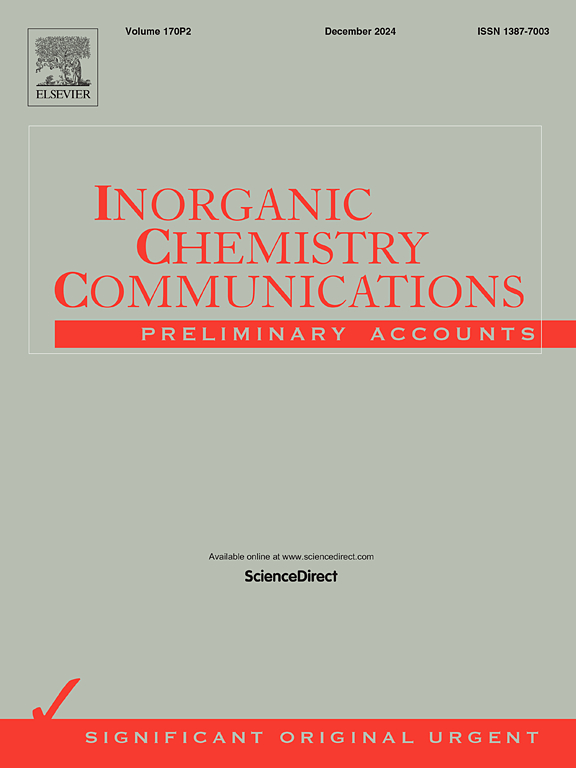磁性双金属纳米催化剂催化乙酰丙酸乙酯转移加氢制γ-戊内酯的比较研究
IF 4.4
3区 化学
Q1 CHEMISTRY, INORGANIC & NUCLEAR
引用次数: 0
摘要
在这项研究中,我们开发了由Fe2O3/ c基双金属催化剂组成的高效纳米催化剂,用于催化乙酰丙酸乙酯(EL)的催化转移加氢(CTH)到γ-戊内酯(GVL)作为生物质增值过程。采用气相吸附吡啶(PY)和2,6-二甲基吡啶(DMP)的色谱滴定法测定催化剂的表面酸度。系统考察了溶剂、温度、压力、催化剂用量和反应时间对γ-戊内酯(GVL)生产效率的影响。在最佳条件下(0.4 g催化剂,220℃,10 bar,反应时间12 h), Co3O4/Fe2O3/C基、NiO/Fe2O3/C基和MnO2/Fe2O3/C基催化剂的转化率分别为94%、96%和89%。这些催化剂对γ-戊内酯(GVL)具有显著的选择性,对Co3O4/Fe2O3/ c基、NiO/Fe2O3/ c基和MnO2/Fe2O3/ c基的选择性分别为95%、95%和82%。这些催化剂的磁性性质使其易于在反应后分离,并且表现出稳定的性能和可重复使用性,最多可达四个循环而没有明显的活性损失。此外,除去催化剂后没有进一步转化的热过滤试验表明,活性物质与固体催化剂结合,证实了其在反应条件下的稳定性和可重复使用性。我们的研究结果强调了这些非均相磁性纳米催化剂是可持续的,环境友好的,并且在催化生物质衍生平台分子氢化到有价值的化学品方面非常有效。本文章由计算机程序翻译,如有差异,请以英文原文为准。

A comparative study of magnetic bimetallic nanocatalysts for catalytic transfer hydrogenation of ethyl levulinate to γ-valerolactone
In this study, we developed efficient nanocatalysts composed of Fe2O3/C-based bimetallic catalysts to employe in the catalytic transfer hydrogenation (CTH) of ethyl levulinate (EL) to γ-valerolactone (GVL) as a biomass valorization process. The surface acidity of the catalysts was determined through chromatographic titration with gas-phase adsorption of pyridine (PY) and 2,6-dimethyl pyridine (DMP). We systematically examined the impact of solvent, temperature, pressure, catalyst amount, and reaction time on γ-valerolactone (GVL) production efficiency. Under optimal conditions—0.4 g catalyst, 220 °C, 10 bar, and a 12-hour reaction time—conversion rates of 94 %, 96 %, and 89 % were achieved for the Co3O4/Fe2O3/C-based, NiO/Fe2O3/C-based, and MnO2/Fe2O3/C-based catalysts, respectively. These catalysts also exhibited significant selectivity for γ-valerolactone (GVL), with selectivities of 95 %, 95 %, and 82 % for Co3O4/Fe2O3/C-based, NiO/Fe2O3/C-based, and MnO2/Fe2O3/C-based, respectively. The magnetic nature of these catalysts facilitated easy separation post-reaction and they exhibited stable performance and reusability up to four cycles without significant loss of activity. Furthermore, the hot filtration test with no further conversion after catalyst removal showed that the active species were bound to the solid catalyst, confirming its stability and reusability under reaction conditions. Our results highlight these heterogeneous magnetic nanocatalysts as sustainable, environmentally friendly, and highly effective for the catalytic transfer hydrogenation of biomass-derived platform molecules to valuable chemicals.
求助全文
通过发布文献求助,成功后即可免费获取论文全文。
去求助
来源期刊

Inorganic Chemistry Communications
化学-无机化学与核化学
CiteScore
5.50
自引率
7.90%
发文量
1013
审稿时长
53 days
期刊介绍:
Launched in January 1998, Inorganic Chemistry Communications is an international journal dedicated to the rapid publication of short communications in the major areas of inorganic, organometallic and supramolecular chemistry. Topics include synthetic and reaction chemistry, kinetics and mechanisms of reactions, bioinorganic chemistry, photochemistry and the use of metal and organometallic compounds in stoichiometric and catalytic synthesis or organic compounds.
 求助内容:
求助内容: 应助结果提醒方式:
应助结果提醒方式:


